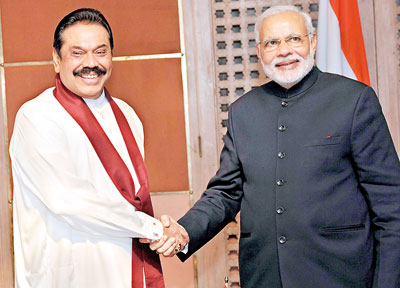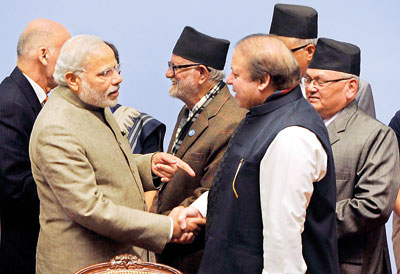Sunday Times 2
A disappointing SAARC summit
The 18th summit of the South Asian Association for Regional Cooperation (SAARC) has concluded in Kathmandu, Nepal, with an outcome far below expectations.
On top of the agenda were three connectivity agreements on road, rail and energy, to be endorsed by the eight SAARC leaders. Only one of these – on energy – has been signed. The remaining two will be discussed again in three months, as Pakistan has not completed its “internal processes” to endorse them.
Even when Pakistan gets ready for these connectivity agreements, they can only be signed after six months when the SAARC foreign ministers meet again.

Indian Prime Minister Narendra Modi meets with Sri Lankan President Mahinda Rajapaksa at the 18th SAARC Summit in Kathmandu on Wednesday. AFP
Overall, there have been no major breakthroughs at the summit and no significant move on fighting terrorism which was presented as a main concern by most of the SAARC leaders, particularly India, Afghanistan, and Nepal. Also, there were no important decisions on flow of investments and financial arrangements to push the economies towards “deeper regional integration”, which was projected as the main theme of the summit.
The summit did set the target of forming a regional economic community in the coming 15 years, but for now, this plan sounds more rhetorical than concrete, just like all the talk about removing poverty, fighting terrorism and speeding connectivity. The Kathmandu Declaration, which the summit produced, lists a lot of other lofty goals like developing a “blue economy” (ocean-based economy) for the region, monitoring cybercrimes, good governance, reinforcing cultural heritage, universal health coverage, food security, etc. It remains to be seen how effective the actions and implementation on these promises will be.
Lack of progress
The SAARC’s activities have been sluggish and irritatingly slow. In its 30 years of existence, it failed to hold 11 annual summits for political reasons, both at the bilateral and internal levels.

Indian Prime Minister Narendra Modi (L) shakes hands with the Prime Minister of Pakistan Nawaz Sharif at the 18th SAARC Summit in the Nepalese capital Kathmandu on Thursday. AFP
India has described the 18th summit as a success, at least for its umbrella agreement on power sharing. However any hard-headed assessment of the summit may not give much satisfaction to Indian policy makers, particularly for the failure to clinch the key connectivity proposals.
India’s Prime Minister Narendra Modi has made “neighbours first” as the cornerstone of his foreign policy. He invited all the SAARC neighbours to witness his oath taking in New Delhi on May 26. At the Kathmandu summit, Modi pitched for “reinvigorating’ and “revitalising” SAARC. In his address at the summit, he encouraged neighbours to join India’s economic opportunities and growth. On the issues of trade, transit, visas, investments, education, health, communication and space technologies, he promised to help its South Asian neighbours. He avoided raising any controversial and sensitive issues that may irritate others. On the topic of terrorism, he only mentioned the anniversary of the November 26 Mumbai attack, but did not get into the disagreements India has with Pakistan over the subject.
Whether Pakistan so intended or not, its reluctance to come on board on the connectivity agreements seems to be a response to India breaking promised bilateral talks. It also signalled its persisting resistance to India expanding its economic engagement with Afghanistan. While transportation of goods and passenger by road between India and Afghanistan through Pakistan is opposed by the associations of truck and bus operators in Pakistan for the fear of losing business, the real difficulty arises from strategic calculations of blocking India from emerging as a competitor to Pakistan in Afghanistan.
China and SAARC
This is in conflict with Pakistan’s claim, strongly put forth by Prime Minister Nawaz Sharif in his Kathmandu address, to offer itself as an energy and economic corridor between South and Central Asia.
On the other hand, Pakistan has been pleading for China’s greater role in South Asia. Most of the other smaller South Asian countries are also supportive of elevating China’s status from that of an observer, to either a full member or a dialogue partner.
The Kathmandu Declaration accepted that observer countries of SAARC may be engaged in “demand driven priority areas”. Almost all of India’s neighbours are attracted to China, both for the lure of greater economic resources, as well as strategic potential of keeping India in “balance”. China has also been keen to play a greater role in South Asia. Its South Asia policy is driven by a sense of vulnerability in Tibet and Xinjiang, by the growing potential of a 1.6 billion-strong South Asian market, and by its trade and maritime interests in the Indian Ocean.
Ever since it was admitted in SAARC as an observer in 2006, China has vastly improved its economic and political engagement with the SAARC countries. At the Kathmandu summit, Chinese Vice Foreign Minister Liu Zhenmin promised a Chinese investment of $30bn for infrastructure development in South Asia and 10,000 scholarships for young South Asians, as a mark of China commitment to the region.
India’s fears
India is prepared for an intensive economic engagement with China at the bilateral level but is not ready or willing to open its strategic space in the region for Chinese presence and influence. It is not too happy to admit China as a SAARC member or even elevate its observer status in the regional organisation. India is resisting pressure from its SAARC neighbours on China under the argument that SAARC has still to achieve internal cohesion and consolidation.
India’s unexpressed fears are on two counts. As a full member, China will get a veto in SAARC affairs as SAARC decisions are taken unanimously. China may therefore block projects that may offer strategic and economic advantage to India. After all, China did restrain both the Asian Development Bank and lately even Japan, from supporting projects in India’s northeastern state of Arunachal Pradesh. China is also opposing Indian oil exploration projects in what it considers disputed waters off Vietnam in the South China Sea.
India is also concerned that even as a dialogue partner, China could breach SAARC solidarity if it conflicts with its perceived economic and strategic interests, as it did with ASEAN in 2012.
India seems to be gearing to integrate its neighbours even in the face of the Chinese challenge and the Pakistani resistance. Indian officials have been informally sending a message that Modi is on a fast train of regional cooperation. Those who will join him are welcome and those who do not, may wait for the next train. How far will Modi succeed in this approach remains to be seen.
SD Muni is the Distinguished Fellow at the Institute of Defence Studies and Analyses in New Delhi and is also an Emeritus Professor at Jawaharlal Nehru University.
Courtesy aljazeera.com

